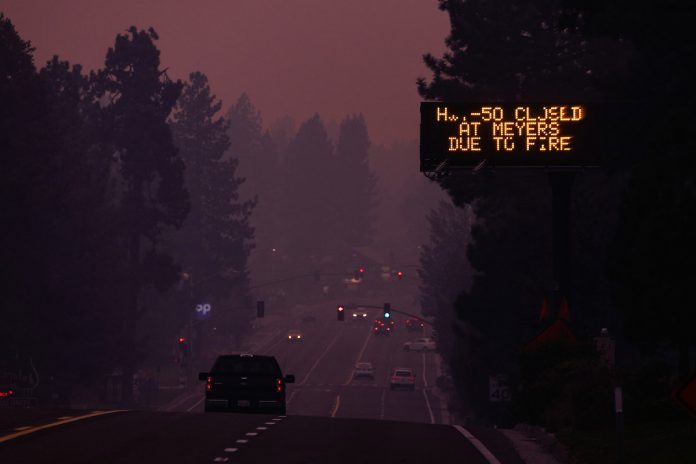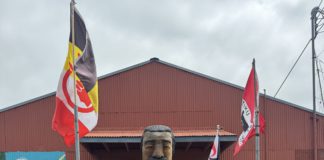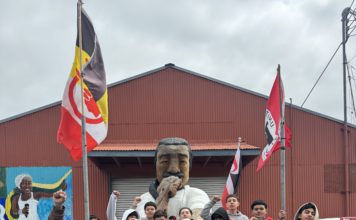TAHOE CITY, Calif.—When the pandemic swept through California last year, Lake Tahoe, the azure gem of the Sierra Nevada, swarmed with city dwellers fleeing to the purity of its alpine air.
Now the stampede has reversed. With a fast-expanding wildfire roaring just one ridge away from the Tahoe basin, residents were in flight this week from smoke so toxic and thick that it spiked past the highest levels on air quality charts.
Pablo Durana, a cinematographer who had just bought a house in South Lake Tahoe last year, was bound for a friend’s place in Santa Monica with his partner.
Tristan Biles, a technology worker who had been working remotely since Halloween from a condo on the edge of a ski slope, was decamping to San Diego to meet his girlfriend.
Phil Abernathy, a scuba diver who works three jobs to afford life among the tall pines and crystalline waters, was headed under a thick, ashen sky to San Francisco. Just inhaling, he said, felt like a “sizable man is standing on my chest.”
The Caldor fire, which has chewed through an area larger than Denver since it started more than 70 miles southwest of Lake Tahoe on Aug. 14, is now a dozen miles south of the lake. The fire was only 12% contained Thursday, when authorities ordered evacuations at the edge of the Tahoe basin.
Amid the exodus, which has become a way of life in parts of the West this disaster-filled summer, there has been a creeping concern that the notion of a safe haven is gone, that there soon will be nowhere to run. Everyone from Bay Area billionaires who bought homes along the shores of the lake to workers stunned by surging real estate prices is seeing a sanctuary suffocate.
The smoke and the wildfires that produce it in the West are coming in a time of drought, heat waves, power cuts and, of course, the coronavirus pandemic.
“This is what climate change looks like,” said Daniel Swain, a climate scientist at UCLA and The Nature Conservancy. “It’s overlapping crises. People try to escape one crisis and stumble into another one.”
With California halfway through its peak fire season, the Caldor fire is only one of about 100 large wildfires burning in the West. The Dixie fire, the second largest in California history, started more than six weeks ago and now has a perimeter of more than 500 miles. On Wednesday alone, four large new wildfires spread in California, drawing increasingly scarce firefighting resources.
The crisis in Tahoe extends far beyond the smoke on the water and fire in the sky of one tourist attraction. For hundreds of thousands of people living over the mountain from the lake, in the high desert of Nevada, wildfire smoke this summer has closed schools, canceled sports events and led longtime residents to ask how much longer they can hold out.
“We’re beside ourselves here,” said Amy Ginder, 47, who has lived for decades in Reno, which has been besieged for weeks by smoke from the huge Dixie fire to the northwest. “We have had smoke in the sky literally since the third week of July — we have been inhaling toxins for five weeks now. You can’t be outside. You can’t breathe. You can’t see the sun.”
She had to buy a gym membership because she could not jog outside, she said, and the community theater group she belongs to spent two weeks rehearsing outdoors in the smoke before canceling its performances last weekend. She suffers from asthma, she said, and fears for her own health and the health of her parents. Visiting indoors with friends is out of the question because of the potential for infection from the COVID-19 delta variant.
“If it were just this summer, you’d just suck it up and move on,” she said. “But it isn’t. It’s the realization that this is our future. Every summer from now on, from July to September, it will be this question: Do we still want to live here? I know so many people who have relocated to Tahoe and Reno, who are up here now thinking, ‘What have I done?’”
At Lake Tahoe, which straddles the California-Nevada border, the summer tourism season that typically winds down in late August jolted to an early halt. The smoke is robbing the lake and its surrounding forests of the vibrant greens and blues that are its trademark.
From the streets of Kings Beach to the vacation mansions of Incline Village, the lake that Mark Twain once called “the fairest picture the whole world affords” looks and smells like the bottom of an ashtray.
Early one morning this week on the path that runs along the lake in Tahoe City, Juan Gomez, a parks-and-recreation employee, marveled at the contrast with last summer, when lakeside towns were swarming with bikers, joggers and shoppers, many of them seeking to outrun the coronavirus.
“There’s nobody here,” Gomez said. “So many people bought houses — they wanted to escape from San Francisco and Sacramento. Now they are going back to I don’t know where.”
Parking lots in Tahoe City were nearly empty, and many restaurants and shops were closed because of the smoke. At the south end of the lake, red vacancy signs glittered through the smoky haze on Lake Tahoe Boulevard. There is no problem getting a room in Tahoe this month.
Yet during the pandemic, buying a home here has often meant entering a bidding war. Home values in the Lake Tahoe area have surged more than 30% since the pandemic started, according to Zillow, a real estate data company. The average price of a home in Tahoe City is now well above $1 million.
At the Olympic Bike Shop in Tahoe City, the smoke has been both a health hazard and a business setback. Bicycles were in short supply for much of the pandemic, as they have been across the country. But this month, as back-ordered bikes arrived in spades, the shortage was not of bikes but of customers. The shop stopped renting out bikes last week, when the U.S. Forest Service, citing the risk of fires and a lack of personnel, closed parks around the lake through Labor Day.
John Percy, co-owner of the shop, has spent $2,000 on air purifiers, and said the shop is now losing money. Last weekend, he fled to Santa Cruz, 260 miles away on the Pacific coast, to escape the smoke.
Molly Schildhause, who works the cash register at the shop, was worried about her 11-month-old and planned to stay with her parents in coastal Marin County on her days off.
“I have two air purifiers running in the baby’s room,” she said. “We keep thinking it’s time to move, but there’s nowhere to go to escape this.”
Durana, 38, who celebrated last year when he and his partner, Carina Hessmer, managed to buy a small wooden house in South Lake Tahoe, said they decided to leave early this week when the smoke started to give Hessmer headaches. They cleared some brush from the yard and then headed south toward Los Angeles, where a friend has offered them a spare room.
“We’re grateful for the firefighters,” he said, “and trying not to let our emotions get the best of us.”
The smoke is more serious for Abernathy, who in addition to scuba diving works in the bike shop three days a week. In 2018, he had half a lung removed to address a birth defect. That had not stopped him from leading a life of outdoor adventure: In March, he made headlines when he used his scuba gear to retrieve a wedding ring that a groom had dropped while exchanging vows on a Lake Tahoe pier.
But the smoke has overwhelmed Abernathy. He now wears industrial-grade respirators when he is outdoors.
On Tuesday, he told Percy at the bike shop that he would be taking leave until the smoke cleared. He will be staying with his partner’s parents in San Francisco.
“I don’t quit easily,” he said. “But you can’t get away from this smoke.”
This article originally appeared in The New York Times.










